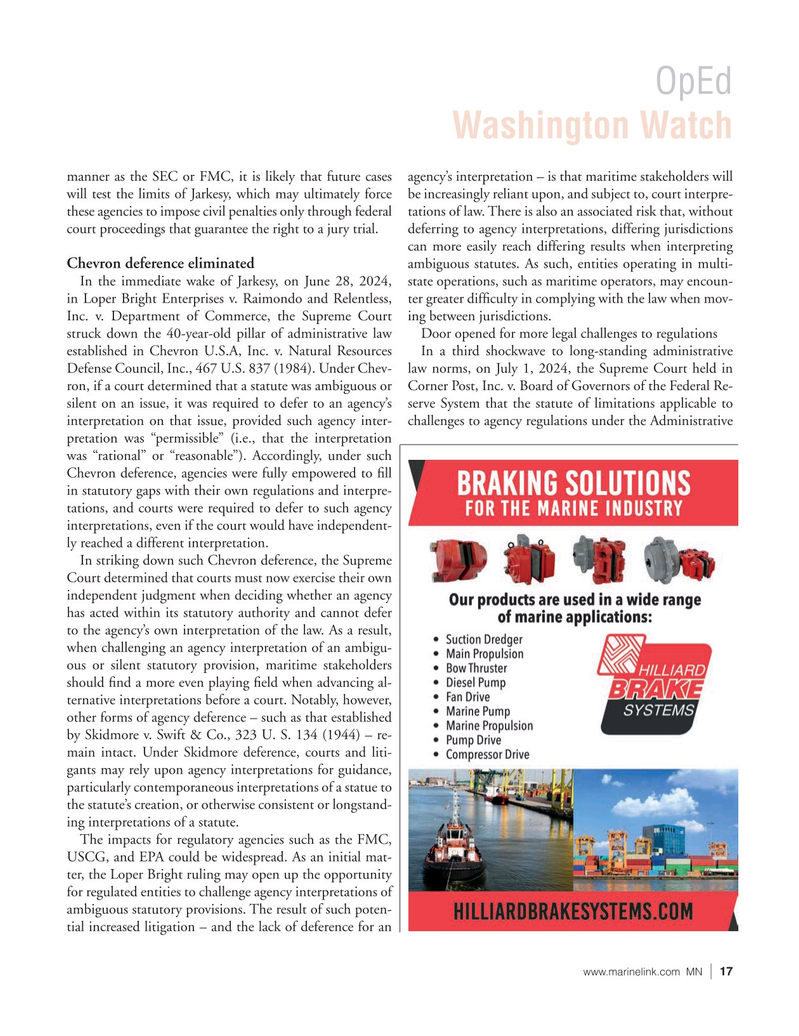
Page 17: of Marine News Magazine (August 2024)
Read this page in Pdf, Flash or Html5 edition of August 2024 Marine News Magazine
OpEd
Washington Watch manner as the SEC or FMC, it is likely that future cases agency’s interpretation – is that maritime stakeholders will will test the limits of Jarkesy, which may ultimately force be increasingly reliant upon, and subject to, court interpre- these agencies to impose civil penalties only through federal tations of law. There is also an associated risk that, without court proceedings that guarantee the right to a jury trial. deferring to agency interpretations, differing jurisdictions can more easily reach differing results when interpreting ambiguous statutes. As such, entities operating in multi-
Chevron deference eliminated
In the immediate wake of Jarkesy, on June 28, 2024, state operations, such as maritime operators, may encoun- in Loper Bright Enterprises v. Raimondo and Relentless, ter greater dif? culty in complying with the law when mov-
Inc. v. Department of Commerce, the Supreme Court ing between jurisdictions.
struck down the 40-year-old pillar of administrative law Door opened for more legal challenges to regulations established in Chevron U.S.A, Inc. v. Natural Resources In a third shockwave to long-standing administrative
Defense Council, Inc., 467 U.S. 837 (1984). Under Chev- law norms, on July 1, 2024, the Supreme Court held in ron, if a court determined that a statute was ambiguous or Corner Post, Inc. v. Board of Governors of the Federal Re- silent on an issue, it was required to defer to an agency’s serve System that the statute of limitations applicable to interpretation on that issue, provided such agency inter- challenges to agency regulations under the Administrative pretation was “permissible” (i.e., that the interpretation was “rational” or “reasonable”). Accordingly, under such
Chevron deference, agencies were fully empowered to ? ll in statutory gaps with their own regulations and interpre- tations, and courts were required to defer to such agency interpretations, even if the court would have independent- ly reached a different interpretation.
In striking down such Chevron deference, the Supreme
Court determined that courts must now exercise their own independent judgment when deciding whether an agency has acted within its statutory authority and cannot defer to the agency’s own interpretation of the law. As a result, when challenging an agency interpretation of an ambigu- ous or silent statutory provision, maritime stakeholders should ? nd a more even playing ? eld when advancing al- ternative interpretations before a court. Notably, however, other forms of agency deference – such as that established by Skidmore v. Swift & Co., 323 U. S. 134 (1944) – re- main intact. Under Skidmore deference, courts and liti- gants may rely upon agency interpretations for guidance, particularly contemporaneous interpretations of a statue to the statute’s creation, or otherwise consistent or longstand- ing interpretations of a statute.
The impacts for regulatory agencies such as the FMC,
USCG, and EPA could be widespread. As an initial mat- ter, the Loper Bright ruling may open up the opportunity for regulated entities to challenge agency interpretations of ambiguous statutory provisions. The result of such poten- tial increased litigation – and the lack of deference for an www.marinelink.com MN 17|

 16
16

 18
18
